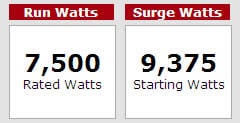
What is a Watt and Why Does it Matter for Backup Power
How to Measure an Appliance's Wattage
People often ask me how to find the right generator for their home. My answer is always simple: Add up all the things you plan to power in watts.
What's a watt? It's simply the electrical consumption of a given appliance and how much power it takes to run it. For example, a 60-watt light bulb requires 60 running watts of electricity to light up your room.
What Does a Watt Measure?
First, let’s have a refresher on common electrical terms. There are three measures of electricity: amps, volts, and watts. An amp measures how much electrical charge flows past a given point in one second. Volts measure the pressure with which electricity flows through a circuit. A watt is the product of voltage and amps and measures the rate at which electrical work occurs, also known as power. [An Ohm is another term worth noting that measures electrical resistance imparted on the current].
Let’s illustrate this through a common analogy—water flowing through a hose. In this example, voltage is represented by water pressure. Amps are represented by the flow of water. Watts, or wattage, is represented by the amount of water flowing through the hose over a period of time.
If you have low water pressure (low voltage) but a wide hose that allows a lot of water to flow (high amps), the flow of water over time is the same as if you had high water pressure (high voltage) but pinched the hose (low amps). The flow of water per time is the result of the water pressure and water flow working together. That’s how wattage works in electricity. It is represented by the formula:
Watts = Amps X Volts
In practical terms, the definition of a watt is the amount of energy an appliance uses during start-up and running. For example, a 60-watt light bulb requires 60 running watts of electricity to light up your room.
Appliances with a motor, however, have a minimum wattage to run and a higher minimum wattage to start. Let's look more closely at the difference between starting watts and running watts.
1. Running Watts
Running (or rated) watts are the amount of watts your appliance needs to keep it running. For example, a refrigerator typically needs 500 watts to run.
2. Surge Watts

Surge (or start-up) watts are the amount of watts your appliance needs to start its motor. For example, it can take up to 2,000 watts (or 2 Kilowatts) just to get the same refrigerator's motor and compressor started.
How to Calculate Wattage
Before buying a generator, you will need to know how many watts are required for your use. There are three simple ways to determine the wattage of your appliances:
1. Data Plate
The easiest way is to just look at the data plate on the back of your appliance. It will tell you how many watts, amps and volts are required to power the appliance.
2. Wattage Meter
3. Multiply Amps by Volts
If your appliance doesn't list watts for some reason but has the number of volts and amps, you can multiply them using the formular above: Watts = Amps x Volts
It's a more roundabout way that still works if you have no other choice.
Once you calculate the wattage of your appliances, you can pick a generator that can power them all. Make sure the generator can handle not just the running watts, but also the starting watts of your motorized appliances.
